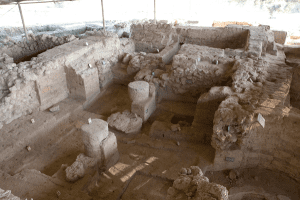Judges 16:25-26, 29-30 (RSV) And when their hearts were merry, they said, “Call Samson, that he may make sport for us.” So they called Samson out of the prison, and he made sport before them. They made him stand between the pillars; [26] and Samson said to the lad who held him by the hand, “Let me feel the pillars on which the house rests, that I may lean against them.” . . . [29] And Samson grasped the two middle pillars upon which the house rested, and he leaned his weight upon them, his right hand on the one and his left hand on the other. [30] And Samson said, “Let me die with the Philistines.” Then he bowed with all his might; and the house fell upon the lords and upon all the people that were in it. . . .
This is one of the most famous stories of the Old Testament. Samson, who judged Israel for twenty years (Judges 16:31), lived in the first half of the 11th century B.C. His death occurred in Gaza (Judges 16:1), which hasn’t been excavated because a city sits on top of the ancient ruins. So we have to look for other temples in regions of ancient Philistine to see if they have two central pillars supporting the roof. Four such buildings have been found. Bryan Windle summarizes the evidence:
The book of Judges describes a unique Philistine temple design with two central pillars supporting the structure. Excavations have unearthed four Philistine temples to date that match the biblical description with two central pillars. In 1972, a Philistine temple [11th century B.C.] was discovered at Tel Qasile [near Tel Aviv]. It consisted of two main parts, an ante-chamber and a main hall, with the structure measuring 26 ft wide by 47 ft long. Within the main hall, two round stone bases were found on which wooden pillars that supported the roof would have rested. Two further Philistine temples discovered at Tel Miqne (ancient Ekron), which have the same design: an antechamber and main hall with its roof supported by two central wooden pillars on stone bases placed along the center axis. A fourth Philistine temple was unearthed by Aren Maeir and his team at Tell es-Safi/Gath, which also contained two central pillars. More importantly, these pillars are typically 6-7 feet apart, making it possible for a large man to dislodge them from the stone bases. (“Top Ten Discoveries Related to the Book of Judges,” Bible Archaeology Report, 6-10-22)
Excavations at Tel Miqne (Ekron) took place between 1981 and 1996: a joint project of the Albright Institute of Archaeological Research and the Hebrew University of Jerusalem, led by Israeli archaeologist Trude Dothan (1922-2016) and American archaeologist Seymour Gitin (b. 1936). In their summary of the excavation, Dothan and Gitin refer to a “Stratum V Building 350” that “contained . . . a monumental entrance hall with two mushroom-shaped stone pillar bases” and another building from “Strata VI and V” that also had “two stone pillar bases.” Stratum VI was dated to 1167-1100 B.C. and Strata V to 1000-1050 B.C.: that is, before or during Samson’s lifetime.
Ekron is mentioned in the Bible in Joshua 13:2-3, 13; 15:11; 19:43. The ark of the covenant was there for a time (1 Sam. 5:10; 6:1-8). Ekron’s destruction was foretold in Zephaniah 2:4. Encyclopedia Britannica (“Zephaniah”) states,
The first verse of the Book of Zephaniah makes him a contemporary of Josiah, king of Judah (reigned c. 640–609 BC). The prophet’s activity, however, probably occurred during the early part of Josiah’s reign, for his criticism of the worship of certain gods in Jerusalem (Baal, Milcom, and the host of the heavens) would have been meaningless after Josiah’s reform, which took place about 623/622 BC.
The city was destroyed by Babylonian king Nebuchadnezzar II in 604 B.C.
Archaeologists Avraham Negev and Shimon Gibson describe what has been discovered in Tel Qasile:
Tell Qasile is . . . about one mile from the Mediterranean coast (presently in the center of a northern suburb of Tel Aviv. The ancient name of the site is unknown; it could be one of the towns of the tribe of Dan in the region of the Yarkon River, such as Harakon (Josh. 19:46). . . .
The major period of occupation at Tell Qasile is Iron Age I (12th-11th centuries BC). The town was probably founded by the Philistines . . .
The temple of Stratum X [last half of the 11th century B.C.] . . . [had] plastered benches . . . constructed along the walls of the antechamber and of the main hall. The roof of the latter was supported by two cedar wood columns which stood on cylindrical stone bases running along the long axis of the hall. (Archaeological Encyclopedia of the Holy Land, New York: Continuum, revised and updated edition, 2003, “Qasile (a) (TELL)”: 414-416)
Tell es-Safi is ancient Gath: the hometown of the most famous Philistine: Goliath (1 Sam. 17:4). It has been excavated since 1996 under the leadership of Aaron Maeir, of Bar-Ilan University’s Martin (Szusz) Department of Land of Israel Studies and Archaeology. He wrote on the weblog devoted to the project, on July 28, 2010:
I thought it would be a nice opportunity to show two of our nicer finds of the season.
The first is a working view of the structure which I believe we can now firmly claim to be a temple! The structure, which has at its center two large pillar bases, and some of the exterior walls, had various cult related objects found in its vicinity. . . . Of interest of course is the similarity to the Philistine temple at Qasile, St. X, with the two pillars in the center of the structure. As noted in the past, this floor plan might be reflected in the Samson story, where the architectural imagery of an Iron Age Philistine temple with two pillars might have served as the background for narrative of Samson standing between two pillars etc.
This information was reported by The Jerusalem Post on the next day. The ark of the covenant also resided for a time in Gath (1 Sam. 5:8), and it (along with Ashdod, Gaza, Ashkelon, and Ekron) was one of the five most important Philistine cities of the Philistines (1 Sam. 6:17). This temple is dated to the 9th century B.C., so it’s later than Samson, but it is more evidence of such Philistine structures with two central pillars, in conjunction with the other three examples that did exist before or during Samson’s lifetime.
Note that it is believed that cedar posts rested on top of stone bases. Thus, it’s not a matter of Samson causing completely stone pillars to crumble (which is what I previously assumed, and probably what most people think), but rather, to simply dislodge the cedar columns (about one foot in diameter) from their bases. In the Tel Qasile temple, the cedar posts were held in place only by the weight of the roof, and were about six to six and-a-half feet apart (descriptions differ): able to be reached by a tall man: especially if he had disproportionately long arms, as many basketball players do. The pillars at the Ekron temple are about 7 and-a-half feet apart. The very fact that these two temples had pillars at different distances from each other illustrates that the pillars at Gaza may very have been even closer together, making it easier still to topple them.
The site, Interbasket.Net contains the article, “The 27 players with the longest wingspans in NBA history” (1-12-23). Wilt Chamberlain’s span was 7’8″: as is current player Dwight Howard’s. Shaquille O’Neal’s was 7’7″, while Alonzo Mourning and Andre Drummond could reach 7’6″, Kevin Durant and Yao Ming, 7’5″, and the great Bill Russell, 7’4″. All of these men could have easily reached the two pillars in the temple at Tel Qasile, standing between them. I could possibly even reach them myself. I’m six feet tall and have disproportionately long arms. My wingspan is 6’4″: the same, incidentally, as that of NBA star Steph Curry (who is 6’2″). Unfortunately, my biceps aren’t nearly as impressive.
Therefore, we know that it was possible for a big and/or tall man to reach the central pillars in at least one of the four Philistine temples that have been discovered. Those are simply facts. But would a man have the strength to pull them down? Well, according to the Guinness World Records, Canadian Gregg Ernst has lifted 5340 pounds. The heaviest train pulled by the neck, according to the same records-keeping source, weighed 71,650 pounds (35.8 tons), using a cable a little larger than 1/16 of an inch (2 mm): achieved by Ukrainian Dmytro Hrunskyi in Dnipro, Ukraine, on 10 May 2022.
Is it naturally possible, then, to do what Samson is reported to have done? Maybe so. It’s not impossible that he was as strong or stronger than Gregg Ernst or Dmytro Hrunskyi. He’s known as one of the most legendary strongmen of all time, after all (probably just behind the semi-mythical Hercules in that regard). In any event, Christians and Jews believe that God answered the recorded prayer of Samson: “O Lord GOD, remember me, I pray thee, and strengthen me, I pray thee, only this once” (Judges 15:28).
Another “problem” with the account of Samson’s death, however, remains: the ostensible prima facie questionability of at least 3,000 people (Judges 16:27) perishing in a temple that was probably not all that large. It comes down to the complex issue of the Old Testament use of numbers. The book of Judges appears to habitually use neatly rounded and as I shall contend, deliberately exaggerated large numbers: “ten thousand” enemies defeated (Judges 1:4), “ten thousand” Moabites killed (3:29), “ten thousand [fighting] men” from the tribes of Zebulun and Naphtali (4:6, 10, 14), 32,000 Israelite soldiers (7:3), “a hundred and twenty thousand men” who died fighting against Gideon (8:10), “about a thousand men and women” who died at the Tower of Shechem (9:49), “forty-two thousand . . . Ephraimites” who died (12:6), Samson killing “a thousand men” with the jawbone of an ass (15:15-16), “four hundred thousand” Israelite soldiers (20:2, 17); “twenty-five thousand one hundred men of Benjamin” killed (20:35, 46).
In comparison, the US military has about 1.3 million active personnel, out of a population of approximately 334 million. It’s estimated that in 1000 B.C., two million Jews lived in Israel.
David M. Fouts’ doctoral dissertation for the University of Michigan (1991) was entitled, The Use of Large Numbers in the Old Testament. He summarized it in his article, “A Defense of the Hyperbolic Interpretation of Large Numbers in the Old Testament” (Journal of the Evangelical Theological Society, 40/3, September 1997, 377-387). Fouts observes:
Those who would challenge an essentially conservative view of Scripture often do so by appealing to passages that involve large numbers. It is therefore necessary that this study be undertaken in order to discover the way that large numbers were used in the OT. Accepting them at face value often leads to internal disharmony with other Biblical passages. There are also the archeological data to contend with. These facts may no longer be ignored by conservative scholars. But the simple dismissal of the numbers as obvious exaggeration or simple error by many scholars is just as dangerous. What is needed is a balanced approach that examines the numbers as they are encountered in the text and suggests a plausible explanation of their use consistent with other Scriptural data and with the demographics demonstrated by regional archeology. . . .
It was not until the Reformation that scholars began accepting the large numbers at face value. Throughout most of early Church history, scholars in general either withheld comment on the passages containing large numbers or interpreted them in a spiritualizing manner. It appears to have been the exception rather than the rule that scholars accepted them at face value. By the time of the Reformation, both Luther and Calvin appear to have done so. . . .
Quite often, large numbers were employed in a hyperbolic fashion in the historiographic literatures of Sumer, Akkad and Assyria, particularly in the royal inscriptional and annalistic genres. The hyperbolic numbers occur in military contexts expressing the number of troops engaged in battle, number of enemies slain or captured, amount of spoil taken, and amount of corvée labor employed. It is evident from my study that no other culture used numbers in excess of 100,000 with the same frequency as does the OT. Where numbers in excess of 100,000 do occur they are found exclusively in military contexts. . . .
If the numbers are simply reflective of a rhetorical device common in ancient Near Eastern literature, . . . one may no longer question the integrity of the record by use of this argument. The large numbers are often simply figures of speech employed to magnify King Yahweh, King David, or others in a theologically-based historiographical narrative.
International Standard Bible Encyclopedia (edited by James Orr, Grand Rapids, Michigan: Wm. B. Eerdmans Publishing Co., 1939, “Number”) concurs:
Numerical symbolism, that is, the use of numbers not merely, if at all, with their literal numerical value, or as round numbers, but with symbolic significance, sacred or otherwise, was widespread in the ancient East, especially in Babylonia and regions more or less influenced by Babylonian culture which, to a certain extent, included Canaan. It must also be remembered that the ancestors of the Israelites are said to have been of Babylonian origin and may therefore have transmitted to their descendants the germs at least of numerical symbolism as developed in Babylonia in the age of Hammurabi. Be that as it may, the presence of this use of numbers in the Bible, and that on a large scale, cannot reasonably be doubted, . . .
***
Practical Matters: Perhaps some of my 4,200+ free online articles (the most comprehensive “one-stop” Catholic apologetics site) or fifty-one books have helped you (by God’s grace) to decide to become Catholic or to return to the Church, or better understand some doctrines and why we believe them.
Or you may believe my work is worthy to support for the purpose of apologetics and evangelism in general. If so, please seriously consider a much-needed financial contribution. I’m always in need of more funds: especially monthly support. “The laborer is worthy of his wages” (1 Tim 5:18, NKJV). 1 December 2021 was my 20th anniversary as a full-time Catholic apologist, and February 2022 marked the 25th anniversary of my blog.
PayPal donations are the easiest: just send to my email address: [email protected]. You’ll see the term “Catholic Used Book Service”, which is my old side-business. To learn about the different methods of contributing, including 100% tax deduction, etc., see my page: About Catholic Apologist Dave Armstrong / Donation Information. Thanks a million from the bottom of my heart!
***
Photo credit: Philistine temple at Tel Qasile [Oren Rozen / Wikimedia Commons / CC BY-SA 3.0]
***
Summary: Four Philistine temples have been found in Israel, and all have two pillars in the center of the main halls: precisely like those in Samson’s death-scene in the Bible.














